
Gesuale B.RFID - read my chips!2004
.pdf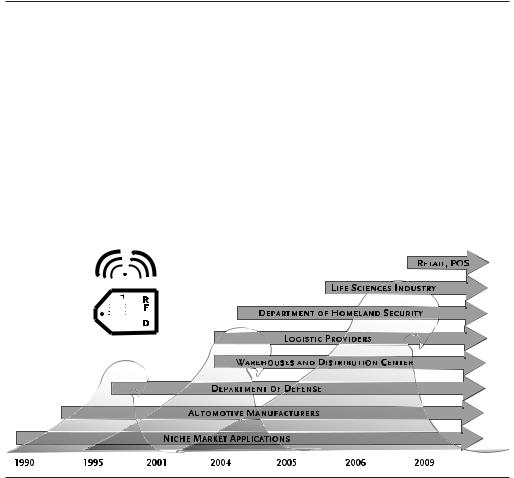
April 2004
RFID Goes Deep Into |
The largest market adopters over the next four years will be the DoD and various links in |
|||
Many Vertical Markets |
the retail supply chain. At the same time, despite the fact that so many RFID discussions |
|||
|
are polarized to these two vertical markets, we believe the technology will have much |
|||
|
broader applications. The Wal-Mart initiative and DoD's mandate to its suppliers have |
|||
|
certainly grabbed headlines, but we believe many other industries will adopt RFID |
|||
|
aggressively during our forecast period. Other verticals also playing a substantial role in |
|||
|
our RFID forecast include the life-sciences market and diversified manufacturers. We expect |
|||
|
the majority of RFID implementations will concentrate on security, tracking items (parts |
|||
|
and people) in the supply chain, tracking items (spare parts or parcels) for customer |
|||
|
service, and controlling access. Each of the major markets we are forecasting is discussed |
|||
|
in more detail below. |
|||
|
Exhibit 28 |
|||
|
|
|
|
|
|
WAVES OF RFID ADOPTION |
|||
|
|
|
|
|
|
|
|
|
|
|
|
|
|
|
|
|
|
|
|
|
|
|
|
|
|
|
|
|
|
Source: Piper Jaffray & Co.
30 | RFID—Read My Chips! Piper Jaffray Equity Research
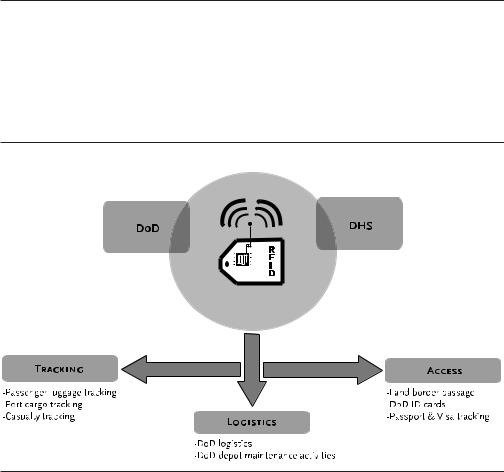
April 2004
The Government Wave The most aggressive adopters of RFID technology in the government will be the DoD and Of RFID Is Here the Department of Homeland Security. These two agencies have collective budget
authority approximating $450 billion annually and have many problems that can be partially solved via RFID technology. Over time we expect to see more government agencies adopt RFID; but given tight budgets across most civil agencies, we believe DoD and DHS are the primary adopters during our forecast period.
Exhibit 29
UNPLUGGING THE GOVERNMENT RFID OPPORTUNITY
Source: Piper Jaffray & Co.
Piper Jaffray Equity Research RFID—Read My Chips! | 31
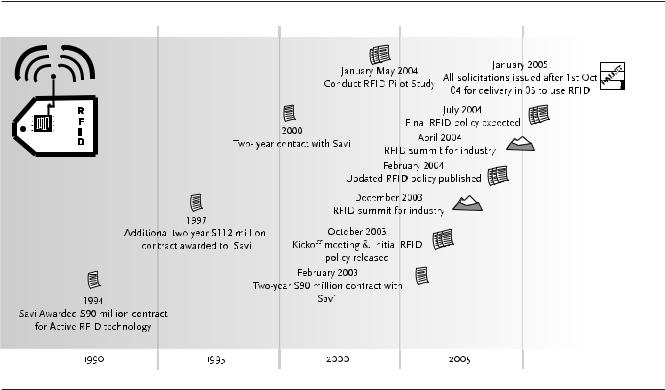
April 2004
Early DoD applications will focus on improving efficiency in its logistics process or its supply chain. There is no other organization in the world that has a more complicated supply chain than the DoD. Success and failure of this chain can mean the difference between life and death. The DoD has been experimenting with the technology for more than a decade and by many accounts has invested well over $100 million during this time period battle testing it in Iraq, Afghanistan, Bosnia, and other places around the world. In 2003, the DoD announced a mandate that its 80,000 suppliers would need to begin utilizing RFID technology during the years 2005-2010. The DoD spends close to $100 billion annually on a broad set of logistics tasks. This will be one of the largest opportunities for RFID vendors through the end of the decade.
Exhibit 30
DOD TIMELINE
Source: Piper Jaffray & Co.
DoD applications will blend active and passive RFID along with other identification technologies in its solutions set implementations. Savi has been a leading provider enabling the DoD to see its logistic channels in high definition. One key program, Total Asset Visibility, was hatched out of logistics problems encountered during Operation Desert Storm. This program uses Savi active RFID tags and infrastructure along with other technology to track food, bullets, and other equipment in more than 45 countries. Many other applications have been piloted by the DoD as well. This could be a pivotal technology to speed critical maintenance on field equipment such as HUMVEES, tanks, aircraft, and so on, although some discretion would be needed for items in the field to ensure that covert status is maintained. The Navy, for example, tested RFID technology to track casualties during conflicts. Some believe this pilot could lead to a "smart dog tag" for soldiers that could transmit items such as name, serial number, blood type, allergies, unit, and other information critical during wartime.
32 | RFID—Read My Chips! Piper Jaffray Equity Research
April 2004
The Department of Homeland Security will also employ RFID technology over the near and intermediate term to improve security. DHS has a budget of roughly $40 billion annually and will likely begin to accelerate the use of RFID technology at key border points. State and local government, airlines, and logistics providers often augment DHS funds to get systems fielded. Airport security, port security, and land-border crossings will be the most significant areas that will deploy RFID technology.
At airports, there are several programs at various stages to begin tagging passenger luggage. Matrics is leading a passive tag program at the nation's seventh busiest airport, McCarran International, Las Vegas. McCarran will deploy Matrics' tags and readers to track luggage from passenger check-in, through security screening, and onto the plane. Delta Airlines is pursuing a pilot to improve security and reduce lost baggage as well. We believe these will be the two seed projects that stimulate others to follow on the checked luggage side. Over time and if privacy concerns can be overcome, smart boarding passes could emerge. RFID is promising in other airport venues as well, including airport employees, runway security, and other perimeter initiatives. RFID is being deployed at land-border crossings to speed commerce at the U.S./Mexican border. Seaport security is being pursued aggressively. DHS and shippers are testing RFID technology as a way to track the more than 38,000 containers that enter U.S. ports each day.
Piper Jaffray Equity Research RFID—Read My Chips! | 33
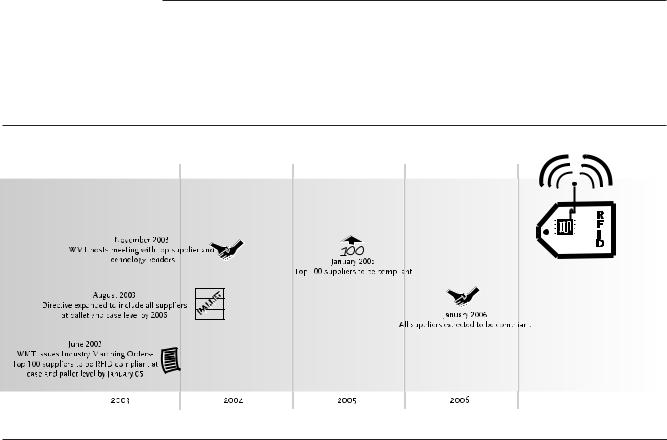
April 2004
Retail—A Look At The |
As we have discussed, Wal-Mart is driving its suppliers to use RFID technology in 2005. |
Shot Heard Around |
Those directly involved are the 100 or so top suppliers that pedal substantial product |
The World |
volume through Wal-Mart outlets. But the aftershock is hitting competitors of Wal-Mart |
|
that do not want to concede any more competitive advantages to the Arkansas retailer, |
|
such as Best Buy, Target, their suppliers, and more. |
Exhibit 31
WAL - MART RFID ADOPTION TIMELINE
Source: Piper Jaffray & Co.
Retailers will likely be one of the most significant beneficiaries of the RFID technology. We believe the major spending on RFID technology during our forecast period will be the suppliers to these superstores, but over time the big retailers will spend at increasing levels to mine the data and bring the technology into the store front. The efficiency gains along the supply chain should reduce headcount requirements, reduce stock outs, reduce human errors, increase supply-chain velocity, and improve inventory efficiency across the board.
One of the larger-than-life examples of a consumer package goods utilizing RFID is Gillette's partnership with Alien to purchase up to 500 million RFID tags.
34 | RFID—Read My Chips! Piper Jaffray Equity Research
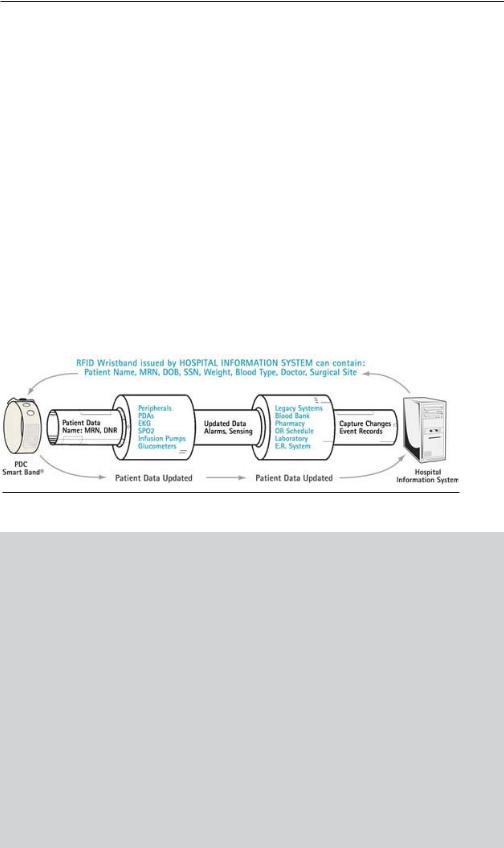
April 2004
Life Sciences—A Patient |
Hospitals and medical organizations will be major adopters of RFID over the next few |
||
RFID Wave Is Coming |
years. RFID can provide nontransferable positive patient identification in order to reduce |
||
|
major medical errors that are common today. Experts estimate that between 44,000 and |
||
|
98,000 deaths occur annually due to medical errors. Patient and specimen |
||
|
misidentification are the leading contributors to the deaths due to medical errors. Besides |
||
|
tragic loss of life, it is estimated that these errors cost the industry more than a billion |
||
|
dollars per year. |
||
|
Other applications likely to find their way into hospitals are RFID-enabled smart cards, |
||
|
patient wristbands, and RFID tracking systems for medication and medical devices. Smart |
||
|
cards would grant area privileges and access to employees based on job role and tenure. |
||
|
Patient wristbands will enable hospitals to track patient data during a hospital stay. The |
||
|
current mechanism of cross-checking patient data using a paper trail or barcode |
||
|
technology is error-prone and too people-intensive. RFID systems could also be employed |
||
|
to ensure that restricted medications are treated appropriately. Another use could be to |
||
|
track the location of critical operating equipment. While we are optimistic that the |
||
|
potential uses of RFID in the health care setting are extremely large, we believe the market |
||
|
will take longer to develop than many of the other markets in our forecast. |
||
|
|
Exhibit 32 |
|
|
|
|
|
|
|
HOSPITAL DEVICES |
|
Source: Precision Dynamics Corporation
SIDEBAR - FDA MANDATES
In February of this year, the FDA issued guidelines for the pharmaceutical industry to protect against counterfeit drugs using RFID. The FDA wants drug makers, distributors, and pharmacists to adopt the new technology by 2007. Though these guidelines are not mandatory, the pharmaceutical industry has indicated its willingness to adopt the technology by 2007.
RFID tags will be attached to the drug packages at point of origin with manufacturer information and other related data as date of manufacture. As the package moves down the supply chain, additional information will be added to the tag. This information can be used at every point in the supply chain to authenticate the legitimacy of the drug.
Though U.S. drug supply is generally secure, concern about drug safety is on the rise, triggered mainly by two high-profile cases in 2003 involving Pfizer's blockbuster cholesterol drug Lipitor and Amgen's anemia drug Procrit, used often by cancer and AIDS patients. According to the FDA, open investigations related to drug counterfeit cases in the United States have increased fourfold from around five in the late ‘90s to little more than 20 in 2003.
Piper Jaffray Equity Research RFID—Read My Chips! | 35

April 2004
Transportation And
Logistics—Riding The
RFID Wave
Manufacturing
Logistics companies are looking for means to improve the throughput of the goods sorting process. It is during the sorting process that packages are placed in different conveyors and bins based on the destination. If the throughput of the sorting process can be increased, the logistic companies will be able to ship more packages and also delay the pickup time. The additional revenue will tremendously boost the bottom line, as very little variable costs will be incurred for the additional packages.
Manufacturers are faced with intense pressure to cut costs and improve quality along with the increasing need to offer customized products to a larger and global, but increasingly fragmented, base of customers. Customers are increasingly demanding more customized products, and this is causing manufacturers to incorporate many options in the products or produce products in various configurations. Cars and personal computers are the most common examples of these customized products. The ability to manage inventory with increasing sales and product variety is a critical success factor as illustrated by computer maker Dell.
Exhibit 33
DELL SALES AND INVENTORY
|
40 |
|
|
|
|
|
|
|
100 |
|
|
35 |
|
|
|
|
|
|
|
90 |
|
|
|
|
|
|
|
|
|
|
|
|
|
30 |
|
|
|
|
|
|
|
80 |
|
|
|
|
|
|
|
|
|
70 |
Inventory Turns |
|
|
|
|
|
|
|
|
|
|
||
|
25 |
|
|
|
|
|
|
|
60 |
|
Sales |
|
|
|
|
|
|
|
|
||
20 |
|
|
|
|
|
|
|
50 |
||
15 |
|
|
|
|
|
‘ |
|
40 |
||
|
|
|
|
|
|
|
||||
10 |
|
|
|
|
|
|
|
30 |
||
|
|
|
|
|
|
|
|
20 |
|
|
|
|
|
|
|
|
|
|
|
|
|
|
5 |
|
|
|
|
|
|
|
10 |
|
|
|
|
|
|
|
|
|
|
|
|
|
0 |
|
|
|
|
|
|
|
0 |
|
|
1987 |
1989 |
1991 |
1993 |
1995 |
1997 |
1999 |
2001 |
2003 |
|

 Sales in $B
Sales in $B
 Inventory turns
Inventory turns
Source: Piper Jaffray & Co. and company reports
36 | RFID—Read My Chips! Piper Jaffray Equity Research

April 2004
Manufacturers have been one of the early adopters of technology, although not at a very large scale. RFID has been a panacea for manufacturers. The technology has helped manufacturers to implement just-in-time (JIT) inventory management systems by providing greater visibility in the supply chain. Accurate data related to inventory stock, in-process inventory, shipping status and date, exact location of inventory, etc., can be gathered in seconds, literally by a mouse click.
RFID has helped manufacturers to improve quality and implement increasingly complex manufacturing runs resulting from the trend toward mass customization. For example, RFID tags can be used to record all of the steps performed and parts added on an item as it passes through the assembly line. As an item passes through the assembly line, a reader attached at every assembly station reads the RFID information and based on that information automatically instructs the assembly-line worker about the parts to be added or operations to be performed. This not only cuts down errors but saves time as the operator does not have to spend time in determining which parts should be added and which operations have to be performed on the item.
SIDEBAR - FORD AND ESCORT MEMORY SYSTEMS
Ford used RFID at its Cuautitlan, Mexico facility to cut down on errors and costs in its truck production operations. Escort Memory Systems (EMS) of Scotts Valley, CA was selected to help Ford with the technology implementation.
Ford had a manual coding system involving paper identification sheets for tracking truck and auto frames as they made their way through the final assembly, paint, and body shop areas of the production line. These paper tracking sheets were being lost, misplaced, destroyed, and even worse, getting switched in the manufacturing process. This made the quality control difficult and costly. For example, a switch in tracking sheets can result in a car or truck being painted the wrong color.
The RFID solution provided by EMS proved to be very effective for tracking and routing auto bodies through the production line. An RFID tag was attached to the vehicle skid and programmed with a coded number that indicated the operations needed to be performed on the vehicle. Information such as vehicle color and interior trim could be gathered from the coded number. As each operation is completed, the coded number is updated in the RFID tag and this ensures that operations are not performed twice. At the end of the production line, the RFID tag can be checked to make sure all steps have been performed and nothing is missing.
Piper Jaffray Equity Research RFID—Read My Chips! | 37
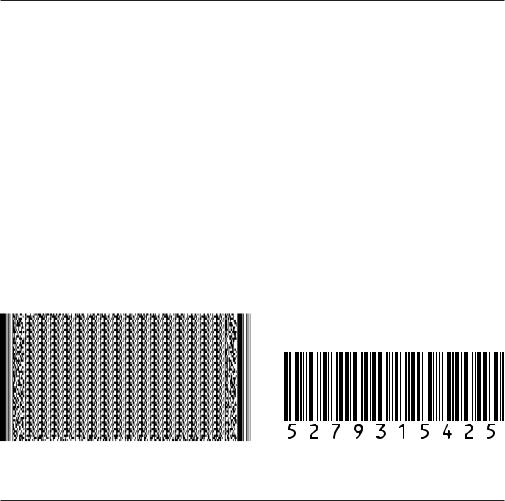
April 2004
RFID Versus The |
Barcodes are the most prevalent current automatic identification solution. Other solutions |
Incumbent Auto-ID |
include smart cards and optical character recognition. Barcode technology is simple and |
Solutions |
fairly inexpensive if the human costs are not included in the cost calculation. A major |
|
advantage barcodes have is that many supply-chain infrastructures are built to optimize |
|
barcodes. Major drawbacks include limited memory space, a predisposition to human |
|
error, and a lack of security features. |
|
Barcode: Barcode consists of a field of bars and white gaps of varying widths arranged in a |
|
parallel fashion and can be found on most packaged goods bought in supermarkets. This |
|
pattern of black and white spaces, coupled with their width, represents numerical or |
|
alphanumeric data. Barcode patterns can be printed easily on plain paper, thermal paper, |
|
or any other kind of surface such as metal or plastic. The codes are read using laser |
|
scanners, which use the reflection of a laser beam from the black and white barcode to |
|
encode the data. |
|
Exhibit 34 |
|
|
|
BARCODE ILLUSTRATION |
2-dimensi0nal barcode |
1-dimensi0nal barcode |
Source: Piper Jaffray & Co.
38 | RFID—Read My Chips! Piper Jaffray Equity Research

April 2004
Optical Character Recognition: Optical character recognition (OCR) technologies can read data printed in human readable form. The data is optically scanned into a computer and special software translates the image into data that can be used for further processing. This technology was invented in the 1960s and is still widely used, especially in document management and banking applications. Almost all bank checks are processed using OCR.
OCR has a few significant advantages over other auto-ID technologies. Data can be read visually in emergencies or at the time of system failure. In addition, data density is higher than barcode although less than RFID. Disadvantages include high price and complex technology implementation.
Exhibit 35
OPTICAL CHARACTER RECOGNITION EXAMPLE
Source: Piper Jaffray & Co.
Smart Cards: While smart cards have been in circulation for some time, use of smart cards is accelerating post-9/11. Smart cards are plastic cards, similar to credit cards, with memory for data storage and an optional microprocessor for computing capabilities. The gadgetry on the card makes the cards extremely secure against unauthorized access and manipulation. Due to their security features, smart cards are chiefly used for secure applications such as financial transactions and access control. Prior to September 11, and even today, Europe remains ahead of the United States in terms of smart card use.
Smart cards have been widely adopted in secure applications although the form factor and relatively high cost have limited the use of the cards in other applications. These barriers are falling, opening the door for broader use.
Exhibit 36
SMART CARD ILLUSTRATION
Magnetic Stripe
Smart card chip
Cody Tesnow
Front |
Back |
|
|
Source: Piper Jaffray & Co.
Piper Jaffray Equity Research RFID—Read My Chips! | 39
